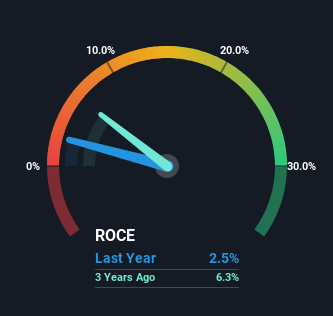- United States
- /
- Basic Materials
- /
- NasdaqCM:SMID
Smith-Midland (NASDAQ:SMID) May Have Issues Allocating Its Capital
What are the early trends we should look for to identify a stock that could multiply in value over the long term? Firstly, we'll want to see a proven return on capital employed (ROCE) that is increasing, and secondly, an expanding base of capital employed. Basically this means that a company has profitable initiatives that it can continue to reinvest in, which is a trait of a compounding machine. However, after investigating Smith-Midland (NASDAQ:SMID), we don't think it's current trends fit the mold of a multi-bagger.
Return On Capital Employed (ROCE): What Is It?
Just to clarify if you're unsure, ROCE is a metric for evaluating how much pre-tax income (in percentage terms) a company earns on the capital invested in its business. The formula for this calculation on Smith-Midland is:
Return on Capital Employed = Earnings Before Interest and Tax (EBIT) ÷ (Total Assets - Current Liabilities)
0.025 = US$1.1m ÷ (US$56m - US$13m) (Based on the trailing twelve months to March 2023).
Therefore, Smith-Midland has an ROCE of 2.5%. Ultimately, that's a low return and it under-performs the Basic Materials industry average of 11%.
Check out our latest analysis for Smith-Midland

Historical performance is a great place to start when researching a stock so above you can see the gauge for Smith-Midland's ROCE against it's prior returns. If you want to delve into the historical earnings, revenue and cash flow of Smith-Midland, check out these free graphs here.
So How Is Smith-Midland's ROCE Trending?
On the surface, the trend of ROCE at Smith-Midland doesn't inspire confidence. Around five years ago the returns on capital were 8.1%, but since then they've fallen to 2.5%. However, given capital employed and revenue have both increased it appears that the business is currently pursuing growth, at the consequence of short term returns. And if the increased capital generates additional returns, the business, and thus shareholders, will benefit in the long run.
What We Can Learn From Smith-Midland's ROCE
While returns have fallen for Smith-Midland in recent times, we're encouraged to see that sales are growing and that the business is reinvesting in its operations. And the stock has done incredibly well with a 153% return over the last five years, so long term investors are no doubt ecstatic with that result. So should these growth trends continue, we'd be optimistic on the stock going forward.
One final note, you should learn about the 3 warning signs we've spotted with Smith-Midland (including 1 which doesn't sit too well with us) .
While Smith-Midland may not currently earn the highest returns, we've compiled a list of companies that currently earn more than 25% return on equity. Check out this free list here.
New: Manage All Your Stock Portfolios in One Place
We've created the ultimate portfolio companion for stock investors, and it's free.
• Connect an unlimited number of Portfolios and see your total in one currency
• Be alerted to new Warning Signs or Risks via email or mobile
• Track the Fair Value of your stocks
Have feedback on this article? Concerned about the content? Get in touch with us directly. Alternatively, email editorial-team (at) simplywallst.com.
This article by Simply Wall St is general in nature. We provide commentary based on historical data and analyst forecasts only using an unbiased methodology and our articles are not intended to be financial advice. It does not constitute a recommendation to buy or sell any stock, and does not take account of your objectives, or your financial situation. We aim to bring you long-term focused analysis driven by fundamental data. Note that our analysis may not factor in the latest price-sensitive company announcements or qualitative material. Simply Wall St has no position in any stocks mentioned.
About NasdaqCM:SMID
Smith-Midland
Smith-Midland Corporation invents, develops, manufactures, markets, leases, licenses, sells, and installs various precast concrete products and systems.
Outstanding track record with flawless balance sheet.
Market Insights
Community Narratives



